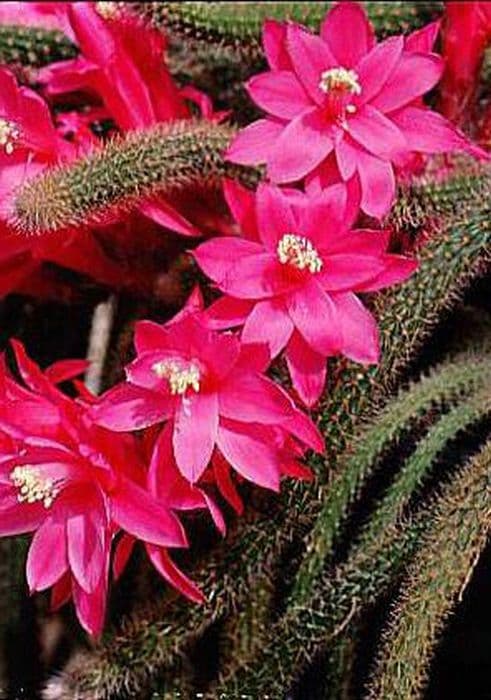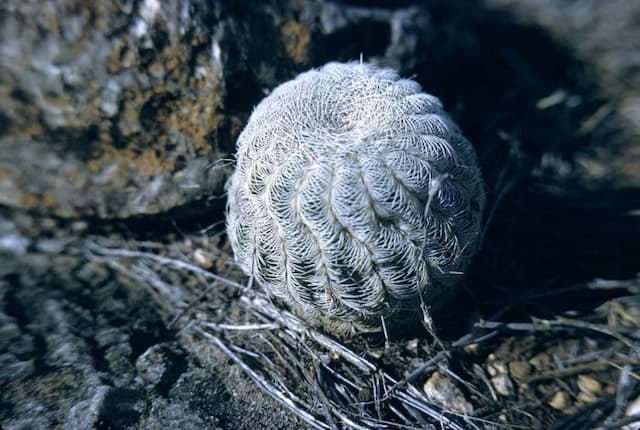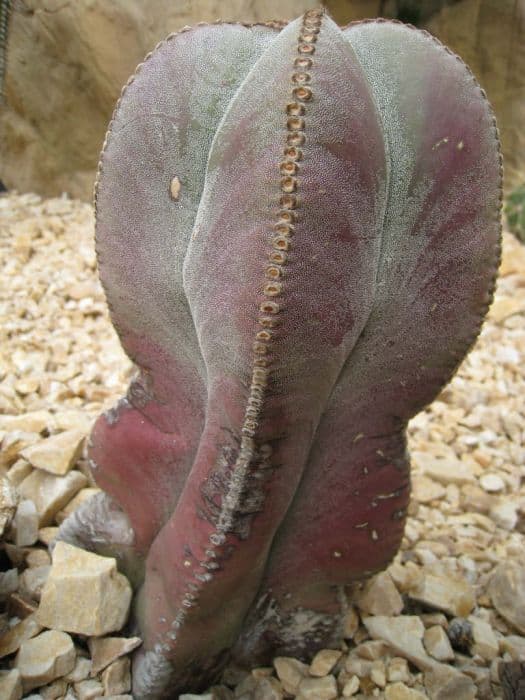Rose Pincushion Cactus Mammillaria zeilmanniana

ABOUT
The plant commonly known as the Rose Pincushion Cactus is a striking and charming specimen to behold. With a round, ball-like shape, it can often be seen with multiple offsets that cluster around the parent plant, giving it a full and clustered appearance. The surface of the main body is adorned with numerous tubercles—little raised bumps—from which spines emerge. For this cactus, the spines are a prominent feature. They come in two types: the radial spines, which are numerous and create a sort of halo around each tubercle, and the central spines that are usually more prominent, fewer in number, and can sometimes have a darker, more vibrant hue. These spines weave together to form a protective mesh over the cactus body. The most captivating time for the Rose Pincushion Cactus is when it blooms. The flowers emerge ring-like around the top of the cactus, creating a crown of blossoms that is both delightful and surprising. The flowers are typically of a deep pink or magenta color, giving a stark and beautiful contrast to the green of the cactus and the pale tones of the spines. After the flowering season, the plant might also produce small, club-shaped fruits that add to its decorative appeal. Overall, the appearance of the Rose Pincushion Cactus is one of rounded symmetry, armored with a dense arrangement of spines, which softens when adorned with the vibrant ring of flowers. It is a compact and formidable-looking plant that simultaneously showcases a delicate and vivid splash of color which can be especially appreciated when in bloom.
About this plant
 Names
NamesFamily
Cactaceae
Synonyms
Rose Pincushion Cactus, Pink Crown, Zeilmann's Mammillaria, Zeilmann's Nipple Cactus
Common names
Mammillaria crinita subs. zeilmanniana, Chilita zeilmanniana, Neomammillaria zeilmanniana, Ebnerella zeilmanniana.
 Toxicity
ToxicityTo humans
Rose Pincushion Cactus (Mammillaria zeilmanniana) does not contain toxic substances that are harmful to humans. It is not considered poisonous if ingested. However, the sharp spines can cause physical injury if handled improperly.
To pets
Rose Pincushion Cactus (Mammillaria zeilmanniana) is not known for being toxic to pets. However, similar to humans, the spines can cause physical injuries, such as punctures or scratches, if a pet tries to chew or swallow the plant.
 Characteristics
CharacteristicsLife cycle
Perennials
Foliage type
Evergreen
Color of leaves
Varies
Flower color
Pink
Height
4 inches (10 cm)
Spread
6 inches (15 cm)
Plant type
Cactus
Hardiness zones
9
Native area
Mexico
Benefits
 General Benefits
General Benefits- Easy to care for: Mammillaria zeilmanniana, commonly known as Rose Pincushion Cactus, is a low-maintenance plant ideal for beginners or busy individuals.
- Decorative appeal: With its attractive pink flowers and distinctive spiny appearance, it adds aesthetic interest to any indoor or outdoor setting.
- Drought tolerance: As a succulent, it is highly drought-resistant, requiring minimal watering and able to thrive in dry environments.
- Compact size: Its small size makes it perfect for cultivating in containers, making it suitable for small spaces and windowsills.
- Propagation: The Rose Pincushion Cactus can be easily propagated from offsets, allowing gardeners to expand their collection or share with others.
- Long blooming period: It often has a prolonged flowering period, offering a display of blossoms for a significant portion of the year.
- Stress reduction: Like many plants, caring for Mammillaria zeilmanniana can provide a sense of calm and reduce stress through the nurturing process.
 Medical Properties
Medical PropertiesThis plant is not used for medical purposes.
 Air-purifying Qualities
Air-purifying QualitiesThis plant is not specifically known for air purifying qualities.
 Other Uses
Other Uses- Mammillaria zeilmanniana, commonly known as Rose Pincushion Cactus, can be utilized as a natural art medium where the spines serve as delicate anchors for attaching lightweight decorations or jewelry elements.
- These cacti are sometimes used in miniature gardens to create a desert-themed landscape which can be an educational tool for teaching about arid environments and their flora.
- The compact size and attractive appearance of the cactus makes it suitable for use in living art pieces, such as sculptural arrangements and table centerpieces.
- The Rose Pincushion Cactus can act as a humidity indicator for indoor environments; its soil moisture levels can be a visible cue for the ambient humidity conditions.
- This cactus species can be cultivated as part of a hobbyist's collection, focusing on the phenotypic variations that arise from selective breeding practices.
- Photographers may use the distinct shape and colors of Rose Pincushion Cactus as a unique subject for macro photography and botanical studies.
- The structural form of Mammillaria zeilmanniana can be inspiring to artists and designers, potentially influencing patterns or shapes in fashion and textiles.
- It can be used as a natural barrier to delineate spaces in a terrarium, preventing small animals from crossing into different sections.
- Due to its slow growth, this cactus is ideal for long-term space experiments concerning plant growth and survival in microgravity environments.
- As a gift, the Rose Pincushion Cactus can be a symbol of resilience and self-sufficiency, representing the ability to thrive in challenging conditions.
Interesting Facts
 Feng Shui
Feng ShuiThe Rose Pincushion Cactus is not used in Feng Shui practice.
 Zodiac Sign Compitability
Zodiac Sign CompitabilityThe Rose Pincushion Cactus is not used in astrology practice.
 Plant Symbolism
Plant Symbolism- Resilience: The Rose Pincushion Cactus (Mammillaria zeilmanniana) can thrive in arid conditions with minimal water, symbolizing the ability to endure and adapt to hard environments.
- Independence: As a cactus, it is often associated with self-sufficiency and the capacity to stand alone without needing external support.
- Protection: Its spiky exterior serves as a natural defense mechanism, signifying protection and a barrier against adversity.
- Beauty amid adversity: Despite its harsh living conditions, it blooms with attractive pink flowers, symbolizing that beauty can emerge from tough situations.
 Water
WaterFor the Rose Pincushion Cactus, it is best to water sparingly but deeply, ensuring that the soil is completely dried out before watering again. During the active growth season in spring and summer, water approximately every 7-10 days with about 2-3 ounces of water per session, depending on the size of the pot. In the dormant winter period, reduce watering to once a month, using no more than 2 ounces of water. Overwatering can lead to root rot, so it's crucial to provide good drainage and to never let the cactus sit in standing water.
 Light
LightThe Rose Pincushion Cactus thrives in bright, indirect sunlight. Position it in a spot where it can receive plenty of light, but avoid direct midday sun, which can scorch the plant. An east-facing or west-facing window is ideal to provide the optimal light conditions necessary for the cactus to flourish.
 Temperature
TemperatureThe Rose Pincushion Cactus prefers warm conditions and should be kept at temperatures between 70°F and 80°F for optimal growth. It can survive minimum temperatures down to around 50°F, but it should not be exposed to prolonged periods of cold. During the winter, it's important to keep the plant in a location that does not drop below this minimum range to prevent cold damage.
 Pruning
PruningPruning of the Rose Pincushion Cactus is generally not required, as it maintains its compact shape naturally. However, if you need to remove damaged or diseased spines, do so carefully with sterilized tools. The best time for this minimal pruning is in the spring, when the cactus is entering its active growth phase.
 Cleaning
CleaningAs needed
 Soil
SoilRose Pincushion Cactus prefers a well-draining soil mix comprised of one part potting soil, one part perlite or coarse sand, and one part pumice or fine gravel. The ideal soil pH should range between 6.0 and 7.5 to ensure healthy growth.
 Repotting
RepottingRose Pincushion Cactus should be repotted every two to three years, or when the plant outgrows its container, to refresh the soil and allow room for growth. It’s best to repot during the warmer months when the cactus is actively growing.
 Humidity & Misting
Humidity & MistingRose Pincushion Cactus thrives best in low to moderate humidity conditions, typical of its natural desert habitat. Aim to keep the humidity levels around 10% to 30%, as high humidity can lead to fungal issues and plant stress.
 Suitable locations
Suitable locationsIndoor
Place in bright, indirect light and ensure pot has drainage.
Outdoor
Full to partial sun; protect from intense afternoon light.
 Life cycle
Life cycleMammillaria zeilmanniana, commonly known as Zeilmann's Mammillaria, begins its life cycle as a seed, which requires a warm climate and well-drained soil to germinate. After germination, the seedling develops into a small cactus with a spherical shape that slowly matures, featuring tubercles and areoles from which spines emerge. As it grows, Zeilmann's Mammillaria may produce offsets or "pups" around its base, which can be separated to propagate new plants. It reaches maturity in several years and starts to bloom, typically producing pink or purple flowers encircling its crown during the spring or summer. After pollination, which is assisted by insects or occasionally by self-pollination, the plant produces small fruits that contain new seeds, thus continuing its life cycle. As a perennial, Zeilmann's Mammillaria can live for many years, going through repeated cycles of growth, flowering, and seed production.
 Propogation
PropogationPropogation time
Spring-Early Summer
For the Rose Pincushion Cactus (Mammillaria zeilmanniana), the most popular method of propagation is through offsets. These small clones, often referred to as "pups," naturally form at the base of the parent plant. To propagate, one should ideally wait until late spring or early summer when the plant is actively growing. Separating the pups can be done by gently twisting them off the mother plant or cutting them off with a sharp, sterilized knife. Once removed, the offsets should be allowed to callous over for a few days to a week in a warm, dry location. After they have calloused, the pups can be planted in a well-draining cactus mix, positioned so that the bottom third of the offset is buried in the soil. It's important to wait a week before watering to prevent rot and allow roots to form, after which the young plants can be cared for in the same manner as the adult Rose Pincushion Cactus.









